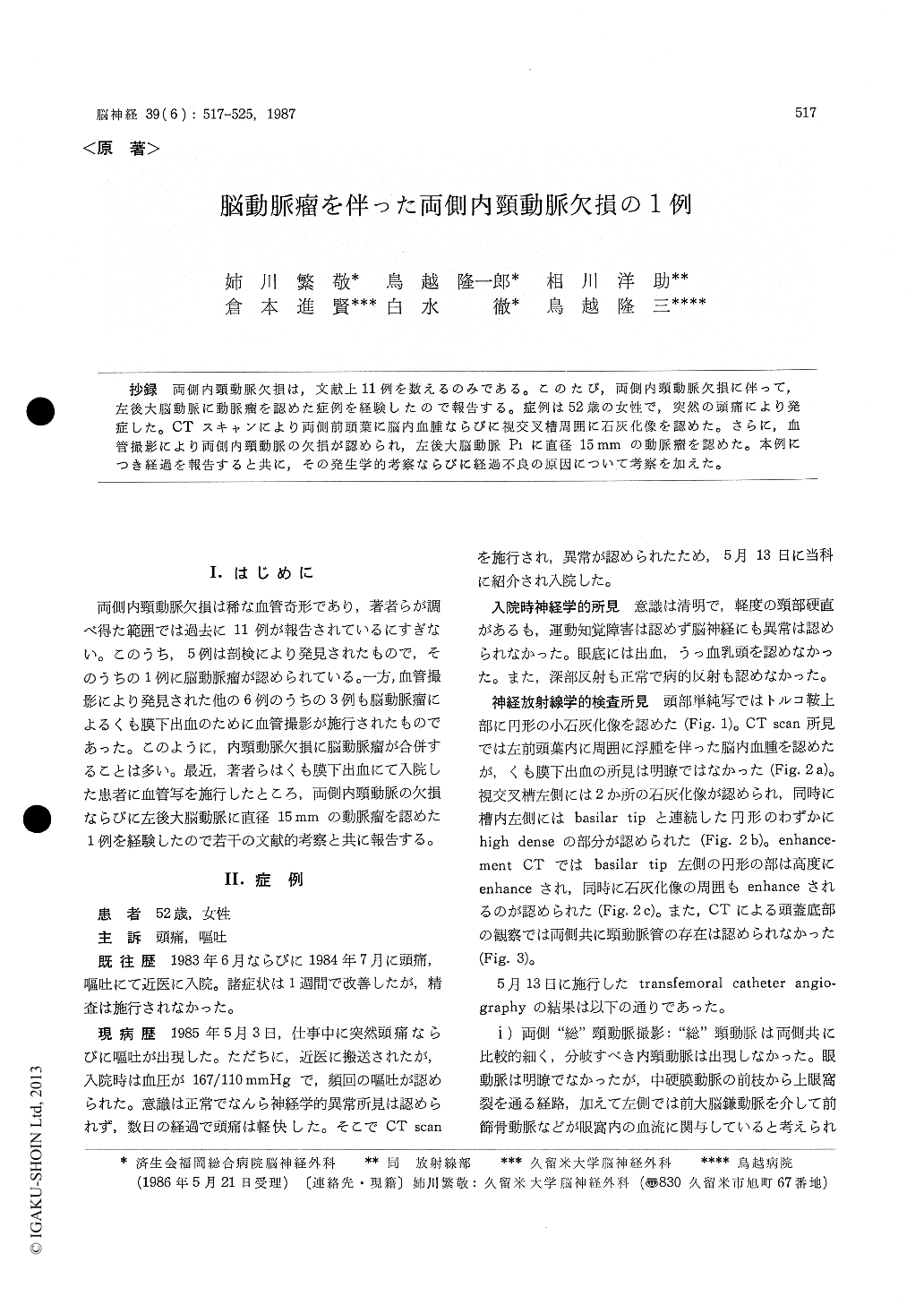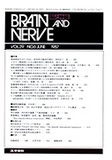Japanese
English
- 有料閲覧
- Abstract 文献概要
- 1ページ目 Look Inside
抄録 両側内頸動脈欠損は,文献上11例を数えるのみである。このたび,両側内頸動脈欠損に伴って,左後大脳動脈に動脈瘤を認めた症例を経験したので報告する。症例は52歳の女性で,突然の頭痛により発症した。CTスキャンにより両側前頭葉に脳内血腫ならびに視交叉槽周囲に石灰化像を認めた。さらに,血管撮影により両側内頸動脈の欠損が認められ,左後大脳動脈P1に直径15mmの動脈瘤を認めた。本例につき経過を報告すると共に,その発生学的考察ならびに経過不良の原因について考察を加えた。
A 52-year-old woman was referred to the De-partment of Neurosurgery, Saiseikai Fukuoka Ge-neral Hospital because of the abnormal findings on CT from a private hospital. She had previously had two attachs of severe headache. In May 1985, she noted severe headache with vomiting and was transported to a nearby hospital. She was hospi-talized there until CT was performed.
On admission, she was clear in consciousness and complained of headache of moderate degree. Neurological examination was normal except for mild nuchal rigidity.
A standard series of roentogenograms of the skull revealed a round calcified area in the supraclinoi-dal region. CT revealed a calcified lesion which must be a vessel in the chiasma cistern just adja-cent to the basilar artery which was relatively larger than normal. Furthermore, no carotid canal was visible in the bilateral petrous bone by means of bony algorythum.
Selective internal carotid angiographies were attempted. There was no evidence of an internalcarotid artery on either sides. Furthermore, the ophthalmic arteries were fed via external carotid systems. A vertebral angiography demontsrated bilateral hypertrophy of the vertebral artery with an aneurysmal shadow in the left P1 of the poste-rior cerebral artery. The supratentorial circulation was maintained via the right posterior communi-cating artery in the right middle cerebral artery and the bilateral anterior cerebral arteries. On the other hand, the circulation of the left middle cerebral artery was maintained by the retrograde filling from the right anterior and posterior cerebral arteries.
Operation was performed by left sylvian approach followed by subtemporal approach. Operative findings showed absence of the left internal carotid with hypotrophy of the left middle cerebral artery. Furthermore, a large aneurysm was noted in the left P1 portion which was obliterated success-fully. After the operation, the patient's condition was good until deterioration of the level of cons-ciousness took place, 8 hours postoperatively. Even though every effort was made, including external decompression, her neurological sign deteriorated gradually. She died 12 days after the operation. Postmortem examinations were not conducted.
Twelve cases of bilateral absence of internal carotid have been reported including the present case. Five cases were diagnosed by necropsy and seven cases, by angiography. In these cases, five cases were accompanied by cerebral aneurysms. Furthermore, in three cases, aneurysms were found in the vertebro-basilar system. These findings indicated that, in bilateral absence of internal caro-tid, there was a remarkably high incidence of a co-existing aneurysm up to 39% and that its loca-tion was in the vertebro-basilar system. These findings suggest that both of two factors which have been discussed as causative factors of aneu-rysm-embryological origin and hemodynamic stress must contribute to the emergence of the aneurysm.
In the author's case, both the vertebral arteries and basilar artery were noted to be hypertrophied. On the other hand, in cases with the absence of internal carotid on one side, aneurysms were most frequently found in the anterior communicating artery which is the most common site of aneurysm. This result may indicate the factor most respon-sible for the aneurysm in the cases with bilateral absence of internal carotid is the hemodynamic factor.

Copyright © 1987, Igaku-Shoin Ltd. All rights reserved.


